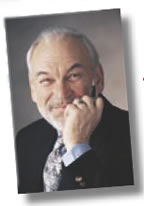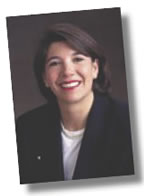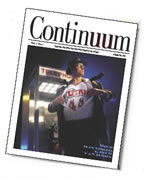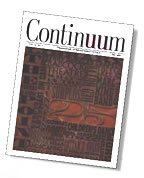
Vol. 16 No. 1 |
Summer 2006 |

Fifteen years. That’s 60 issues. Somewhere in the neighborhood of 2,880 pages. Conservatively speaking, just over a million words. And all of those nouns, verbs, and adjectives serving a single purpose: to tell the story of the University of Utah.
The establishment of Continuum magazine parallels the University of Utah’s ascendancy to the rank of world-class institution. The U has always been a great school, but it’s fair to say that the early Nineties, when Continuum first landed in mailboxes, marked a pivotal moment in University history. It was then that those connected with the school—from faculty and staff to students and administration—took a collective breath and began reaching higher. Continuum’s role and purpose has been to keep up with the U every step of the way.
Now that Continuum is a mature and healthy 15, we’re taking stock of its progress on the pages that follow, celebrating the past and casting an eye to the future. The three former Continuum editors—By Sims, Anne Palmer Peterson, and Theresa Desmond—offer glimpses of their time at the magazine, while also spotlighting the people and ideas at the heart of the U’s phenomenal development and growth over the past 15 years. The magazine’s current editors weigh in on those Continuum covers that inspire them the most.
But looking ahead has always been the U’s strong suit, and writer Kelley J.P. Lindberg takes a jaunt into the future to see what the U will look and feel like in another 15 years. So get ready to meet on the steps of the Park Building in 2021 to compare notes.
Until then, we’ve got another million words to write. Time to get busy.

Three former Continuum editors reflect on the magazine, their responsibilities, and the publication’s legacy.You can judge a magazine’s health and stability by the tenure of its editors. If a magazine’s staff box lists a new name in the top spot every six months, you’re in trouble. But a magazine that can hold on to editors for a few years (a veritable eternity in the profession nowadays), well, that says something about its ability to keep wordsmiths engaged. And so it is with Continuum. Editors tend to dig in and stick around awhile. Here, the magazine’s three former editors offer some insight on why writing about the University of Utah can be so compelling.
J.
Byron “By” Sims
Editor, 1991-1996
 Fifteen
years ago—and, no, it doesn’t seem like yesterday—Continuum
made its debut, born not of necessity but of a recognition that its time
had come. Continuum replaced the tabloid-size Review
that had served for a dozen years as the U’s principal outreach
publication. But the Review had become, frankly, a bit drab,
a black-and-white publication in an era of exploding color and eye-grabbing
graphics. Continuum propelled the U to a new level in presenting
itself to a national constituency.
Fifteen
years ago—and, no, it doesn’t seem like yesterday—Continuum
made its debut, born not of necessity but of a recognition that its time
had come. Continuum replaced the tabloid-size Review
that had served for a dozen years as the U’s principal outreach
publication. But the Review had become, frankly, a bit drab,
a black-and-white publication in an era of exploding color and eye-grabbing
graphics. Continuum propelled the U to a new level in presenting
itself to a national constituency.
Ted Capener, Continuum’s publisher during my tenure as editor, set the tone in the inaugural issue of May 1991. “Continuum will be … an identity of substance uniting discrete parts,” Capener wrote. “Identifying and explaining [the U’s] discrete parts will be the focus of the magazine.”
It was a daunting mission statement at the time, and is no less so today.
Continuum was launched with an air of anticipation and a touch of trepidation. For the first time, a University publication’s funding would depend in part on advertising revenue.
The first cover featured the preeminent geneticist Ray White, seemingly bemused by having half his face composed of pixels. The cover story dealt with U researchers “peeking into the very core of life.”
A newly appointed president named Art Smith beamed from the next cover. He seemed flushed with eagerness to undertake “The Work of Art.”
 So
it went through 20 issues over the ensuing five years, each one stimulating,
challenging, unique. I have no one favorite, but among my favorites is
the Spring 1995 issue. It dealt with House Bill 60, which resulted in
older citizens “learning to have the time of their lives.”
On the cover was pert Phyllis Ford, then 77, peering coquettishly around
a stack of textbooks. She’d probably earned enough credit hours
for several graduate degrees.
So
it went through 20 issues over the ensuing five years, each one stimulating,
challenging, unique. I have no one favorite, but among my favorites is
the Spring 1995 issue. It dealt with House Bill 60, which resulted in
older citizens “learning to have the time of their lives.”
On the cover was pert Phyllis Ford, then 77, peering coquettishly around
a stack of textbooks. She’d probably earned enough credit hours
for several graduate degrees.
Once established, Continuum flourished, the result of colleagues with skill and passion and devotion—and boundless energy. Its nourishment, however, came from the ferment of the U itself, where the ceaseless pursuit of new knowledge and higher achievement is evident from the Huntsman Cancer Institute to Rice-Eccles Stadium.
Whenever “discrete parts” need explanation and exposure through incisive text and crackling design, Continuum is there, ready to “peek into the very core of life” at a vibrant campus.
Today, an “identity of substance” is apparent in every issue. I am privileged to have been at Continuum’s creation.
—“By” Sims BS’57, now retired, is newsletter
editor for the U of U Retired Staff Employees Association, editor of a
newsletter for the Army Chapter of The Chosin Few—a publication
for Korean War veterans of the historic Chosin Reservoir battle in 1950—and
serves on the U’s Veterans Day committee.
Anne
Palmer Peterson
Editor, 1996-2000
 Editing
a university magazine calls to my mind “The Two Enchantments,”
an essay by Professor Emeritus William Mulder BA’40 MA’47
about the charm of studying the exotic and the charm of the familiar.
There is never enough space to give justice to the University’s
depth and breadth. A few issues of Continuum focused intensely on one
theme; I was involved in three. The first concerned University contributions
to the field of aging. The second was on the tricky issue of financing
University operations. When I went to Michigan to interview prospective
U of U president Bernie Machen, he was aghast over that volume. “Why
on earth would you want to share all that with the alumni?” he challenged.
Third, and my favorite, was the fifth anniversary issue, “Expressions
of the West,” about how our location sets us apart yet makes us
an inimitable part of the world.
Editing
a university magazine calls to my mind “The Two Enchantments,”
an essay by Professor Emeritus William Mulder BA’40 MA’47
about the charm of studying the exotic and the charm of the familiar.
There is never enough space to give justice to the University’s
depth and breadth. A few issues of Continuum focused intensely on one
theme; I was involved in three. The first concerned University contributions
to the field of aging. The second was on the tricky issue of financing
University operations. When I went to Michigan to interview prospective
U of U president Bernie Machen, he was aghast over that volume. “Why
on earth would you want to share all that with the alumni?” he challenged.
Third, and my favorite, was the fifth anniversary issue, “Expressions
of the West,” about how our location sets us apart yet makes us
an inimitable part of the world.
In these issues, contributors scrutinized many angles of one essential aspect shaping the academic landscape. In other issues, the challenge was deciding from a substantial list of story ideas just which colleges and departments would be featured. Editors were mindful of the need to share turns in the spotlight.
A quarterly magazine makes timeliness a persistent concern. With that timeline, it’s tough to get a scoop. So, in my mind’s eye I wrote my columns and assigned stories I felt would be of interest to an imaginary alumna in St. Paul. A gymnastics fan and graduate of the class of ’78, she wasn’t always up on the latest news coming out of University Communications. For her, I sought fresh angles on what some on the Wasatch Front may have considered “old news.” So there was the enchantment of writing for far-away readers, clinging to nostalgia but longing for news of their favorite professors, and also writing for readers I’d see on a regular basis.
 My
mantra was give the people what they want—not what the editor thinks
they need. Great runs in men’s and women’s basketball, football,
gymnastics, and skiing made it easier to deliver what many readers wanted.
I was overjoyed with the “Super-Van” story concept highlighting
the college career of mild-mannered basketball player Keith Van Horn ex’97.
We photographed him rushing out of a phone booth, shedding his classroom
attire, revealing a Superman costume beneath. I think Continuum’s
team, from designers to the circulation staff, gives a similar sort of
muscle to our extraordinary faculty and students. Their accomplishments
were a delight to publicize. And what self-respecting journalist can resist
identifying with Clark Kent, star reporter of the Daily Planet? Even if
she works under the guise of academe.
My
mantra was give the people what they want—not what the editor thinks
they need. Great runs in men’s and women’s basketball, football,
gymnastics, and skiing made it easier to deliver what many readers wanted.
I was overjoyed with the “Super-Van” story concept highlighting
the college career of mild-mannered basketball player Keith Van Horn ex’97.
We photographed him rushing out of a phone booth, shedding his classroom
attire, revealing a Superman costume beneath. I think Continuum’s
team, from designers to the circulation staff, gives a similar sort of
muscle to our extraordinary faculty and students. Their accomplishments
were a delight to publicize. And what self-respecting journalist can resist
identifying with Clark Kent, star reporter of the Daily Planet? Even if
she works under the guise of academe.
—Anne Palmer Peterson MPA’00 is researching and writing a history of the University of Utah’s A. Ray Olpin years for the University. She is founding director of the Osher Lifelong Learning Institute, and represents higher education on the Utah Commission on Aging. She is also pursuing a doctorate in international education at the University of London, Institute of Education.
Theresa Desmond
Editor 2000-2004
 Probably
my favorite Continuum to edit was the Fall 2002 issue devoted
to “25 Favorite Things” about the U. It required sifting through
hundreds of nominations, all of which reinforced the fact that the University
is a place well worth exploring. I had figured that covering the U for
Continuum would be like covering a small city, and, indeed, that
issue confirmed that there is plenty beyond the Park Building.
Probably
my favorite Continuum to edit was the Fall 2002 issue devoted
to “25 Favorite Things” about the U. It required sifting through
hundreds of nominations, all of which reinforced the fact that the University
is a place well worth exploring. I had figured that covering the U for
Continuum would be like covering a small city, and, indeed, that
issue confirmed that there is plenty beyond the Park Building.
In fact, there’s plenty underneath the Park Building—tunnels, I learned, connecting to other buildings. The campus is also home to gardens of native plants, hidden attics, many, many mice and rats (in labs), children’s playgrounds, helicopters, a natatorium, a cork room, a cauldron, a ghost, a basement with drawers of bones, art studios, dance studios, concert halls, and thousands of people with wonderful tales to tell.
So, what I remember most about my time as editor, besides the pain of having my photo appear in those editor’s columns, was the pleasure of having too many good stories to pursue. The U is unusually fertile ground, a place where big ideas and pure curiosity thrive. I remember wishing that everyone could have my vantage point as editor, to see the breadth and depth of work being accomplished.
I remember intriguing visits to labs, learning, for example, about birdsong from a biologist whose lab was filled with cages of sweetly singing birds, some outfitted with mini-headphones, so he could learn more about how birds generate sounds. (“You’ve got to be nuts to do this,” he assured me.)
I remember the poignancy of listening to Native American students talk about their plans to become teachers in tribal schools, and their almost crushing sense of responsibility to act as role models for the next generation (“I want to pave the way for others”).
 I
remember interviewing a stonemason who was working on the Legacy Bridge
on September 11, 2001, and who decided, on the spot, to place two stones
vertically, as a tribute to those who died in the World Trade Center attacks,
thousands of miles away. “It hit me so hard and so deeply,”
he said, which is what his story did to me.
I
remember interviewing a stonemason who was working on the Legacy Bridge
on September 11, 2001, and who decided, on the spot, to place two stones
vertically, as a tribute to those who died in the World Trade Center attacks,
thousands of miles away. “It hit me so hard and so deeply,”
he said, which is what his story did to me.
Continuum may be a mere 15 years old, but the institution it covers is mature and replete with fascinating people and stories. I feel very fortunate to have been privy to them.
—Theresa Desmond was a book editor before serving as managing editor (1998-2000) and editor (2000-2004) of Continuum. She is currently senior writer in the chancellor’s office of The City University of New York and lives in New Jersey with her husband, Paul.
